Breeders work tirelessly every year, giving gardeners the latest in grape hybrids and varieties. Among them Hybrid of Furshetny grape bred in Zaporozhye, deserving good reviews of winegrowers.
Despite the fact that its seedlings appeared in nurseries only about ten years ago, winegrowers from different regions were able to evaluate the hybrid form. Buffet is called a promising variety, recommending cultivation on personal plots.
Content
Description
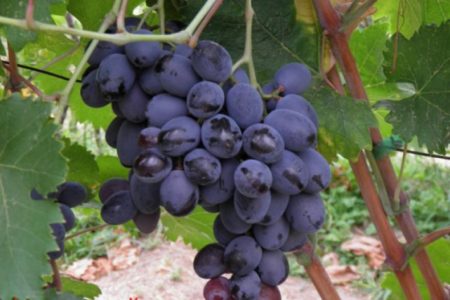 The author of the new hybrid is breeder V.V. Zagorulko (Ukraine). Buffet Buffet appeared on the market in 2008, the parent pair - varieties Kuban and Gift Zaporozhye.
The author of the new hybrid is breeder V.V. Zagorulko (Ukraine). Buffet Buffet appeared on the market in 2008, the parent pair - varieties Kuban and Gift Zaporozhye.
Refers to early or mid-early species, with proper care berries ready for collection in 115-130 days. The timing is approximately August 15-18, but the exact time is determined by the climate of the region, weather conditions of the season, agricultural technology.
Forms quite powerful bushes, characterized by increased shoot formation. According to gardeners, there are 14-16 shoots per square meter of planting area. When planting, take into account the strength of the plants and observe the distance between the bushes. The ripening of the vine is 85-90%.
The leaves are large, curly, with strong cuts. Coloring is bright green. The Reception does not need additional replanting varieties for pollination, as it forms bisexual peduncles.
Grown in different regions, it has established itself well in the middle lane, the Leningrad region, in the Urals. Thanks to early ripening, as well as good indicators of frost resistance, the hybrid manages to yield crops even in areas with a short summer. But to obtain tasty and juicy berries, more sun and heat are required, otherwise sourness will be felt in the pulp. Yield indicators - up to 40-50 kg per adult bush.
Characteristics of berries
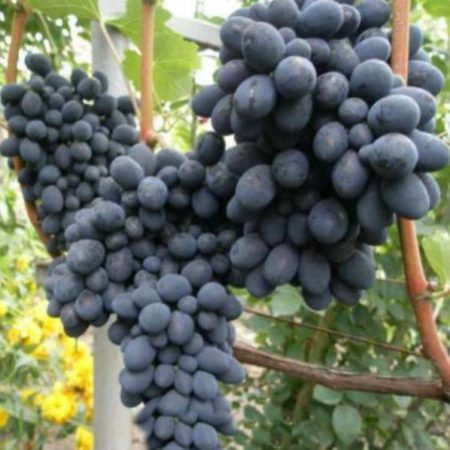 Large, conical-shaped clusters are formed on the powerful vines of the Fourchette. The structure is medium-dense, wings are often formed. By weight - 400-800 grams, but the average weight is 600 grams. The length of the grona is 28-35 cm.
Large, conical-shaped clusters are formed on the powerful vines of the Fourchette. The structure is medium-dense, wings are often formed. By weight - 400-800 grams, but the average weight is 600 grams. The length of the grona is 28-35 cm.
The berries are oval in shape, with dense skin. On the surface there is the finest wax coating. The berries weigh 13-16 grams; large specimens come up to 20 grams.
The pulp is jelly, juicy, does not separate from the skin. The sugar content in the fruits is 18-20%, the acid is 6%. The taste of berries is pleasant, harmonious, with notes of plum, mulberry, raisins. Used as dessert for making homemade wines. On an industrial scale, the Furshetnyi variety is not involved in winemaking (table view). Berries are harvested right on time, otherwise they are amazed at the bushes.
Fruits well tolerate transportation over long distances, do not lose their presentation, taste. According to winegrowers reviews, this grape stored for up to 1.5-2 months in basements or cellars.
Advantages and disadvantages
Ten years for grapes is a short period, so while the buffet table is being tested at the sites of breeders, gardeners of private traders.
Of the positive characteristics noted:
- early ripening;
- high frost resistance (up to -22ºC, sometimes up to -25ºC);
- excellent taste;
- attractive appearance of berries.
Due to its powerful growth, the Fourchette is suitable for decoration of arbors, arches.
Disadvantages:
- requires a large area for planting;
- needs the formation of brushes;
- berries cannot be kept for long on bushes.
Grade resistant to major diseases of the culture, in the middle lane is grown without shelter. In regions with harsh climates, protection for the winter is required, removal from supports.
Seat selection
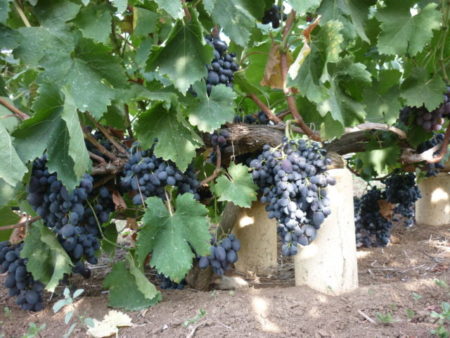 They select a well-lit place, without drafts. The culture is photophilous, for the accumulation of sugar content by berries, a large amount of sun is needed. From the soils fit:
They select a well-lit place, without drafts. The culture is photophilous, for the accumulation of sugar content by berries, a large amount of sun is needed. From the soils fit:
- black earth;
- loam;
- sandstones.
Clay soils are improved by adding sand, sandy soils by adding clay. Salt marshes, wetlands and low places for grape cultivation are not suitable. You can not plant a buffet in places where groundwater is near, water accumulates in spring.
Seedlings are planted in spring, autumn, given the climate of the territory. In the regions of the North-West and Urals, the best time is spring, since in the autumn the bushes often do not have time to adapt to the cold weather. Spring planting is carried out when the soil is warming up, the onset of stable heat.
Dig the soil in advance. During autumn plantings, they begin to prepare the site in August; for plantings in the spring, all work is carried out in the autumn. They make complex fertilizers, nitrogen, humus.
Landing
Landing pits are prepared for the bushes. Taking into account the power of the variety, the pits are placed at a distance of three meters from each other. Depth - 80-100 cm. Drainage is mandatory - pebbles, broken slate, brick.
Prepare a nutrient mixture, mixing humus, sand, ash, soil. The pit is shed with water, part of the mixture is poured into the pit, a grape seedling is placed on this mound and roots are straightened. Next, gently sprinkle the plant with earth, a little tamp, mulch. For mulch, straw, hay, mowed grass are suitable.
Supports for future trellises are laid in advance at the landing site. As the vines grow, they attach the twigs to the wire.
Features of agricultural technology
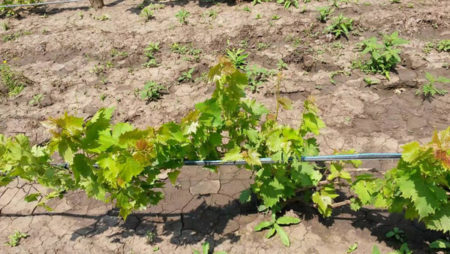
Buffet-type hybrid grapes require adherence to standard agricultural techniques. Features of care are mainly associated with the formation of a bush and bunches, picking berries.
Care
Further care standard:
- top dressing;
- watering;
- bush formation, pruning;
- prevention of infections;
- pest control.
It is necessary to follow the recommendations of specialists who have experienced a buffet table in various conditions.
Watering
Young seedlings often watered, especially if the summer was dry. The hybrid is demanding on moisture, grows faster and forms fruitful shoots.
Adult bushes are watered less often, but more abundantly:
- in spring, if the soil does not contain enough moisture;
- before flowering;
- at the beginning of the formation of fruits;
- before ripening berries;
- in the fall, after harvesting.
Watering in the fall contributes to the accumulation of moisture in the soil until next summer. In humid weather and frequent rains Buffet in the fall after harvesting is not watered.
Top dressing
A vigorous hybrid needs complete nutrition. The first 2-3 years grapes lack the nutrients of the mixture introduced when planting seedlings. Then, every season, the bushes are fed. Use organic and mineral complexes.
In the spring, planting is fed with rotted manure, humus, ash. The introduction of organics improves the structure of the soil, contributes to a better growth of the vine. In the fall, nitrogen supplements are not added to the culture.From mineral additives are suitable:
- ammonium nitrate;
- superphosphate;
- nitrophosk;
- potassium salt.
Gardeners also use complexes: Kemira, Aqarin, Rastvorin, Novofert.
The usual scheme for feeding the buffet at the root:
- early spring (to restore shoots after wintering);
- the second - before the flowering of bushes;
- the third - as soon as the berries begin to form;
- in a state of technical ripeness of berries;
- in the fall, after harvest.
First, nitrogen fertilizers are used, then potash and phosphorus are added. At the fourth, nitrogen is excluded from the diet, since during this period the elements that improve the taste of berries and increase the brushes are important.
In the fall, top dressing is made, if necessary, not every year. If grape grows on well-fertilized soils, refuse autumn fertilizer application.
Foliar spraying is effective, giving a result in a few days. Use:
- boric acid (take 5 grams of the drug in a bucket of water);
- ash infusion;
- superphosphate extract.
Three sprays per season is enough for the crop. They process the bushes in the morning, on a calm day.
Bushes
Buffet is formed every year, starting from the second season. A powerful hybrid without pruning gives many shoots that thicken the planting and reduce yield.
Pruned in the spring, before the movement of the juice or in the fall, when all the leaves fall. Usually the dates are late September and October (depending on the region). Each adult bush leaves no more than 25 branches, pruning is 4-7 eyes.
The formation of the bush is performed for 2-3 years. Properly pruning the vine and giving it the desired shape helps:
- improving the quality of the eyes;
- resistance of bushes to cold snap and frost;
- uniform distribution of growth on the supports;
- creating the right form of bushes;
- optimal illumination of brushes.
An optimal shoot load is provided, which is especially important for a vigorous hybrid.
Most often, during the cultivation of the Buffet, a fan formation is used (both with and without the stem). The shoots are arranged in several tiers, the stems of a three-year-old are cut off, turning them gradually into sleeves.
In the summer, excess leaves are removed, nibbles are tweaked, and embossed. Be sure to remove diseased and deformed branches from the bushes in the fall and spring.
Picking berries
Starting from August 15-18, berries begin to ripen. At the Buffet, they are painted in a characteristic dark blue, almost black color, characteristic of the hybrid, and acquire a pleasant taste. You must not miss the moment of collection, otherwise, even with a slight overexposure in the hands, a large number of grape grapes appear.
The shape of the berries lasts for several days, then the flesh loses taste. The brushes collected in time are stored for up to two months, hanging in dry cellars, in attics.
Preparation for winter
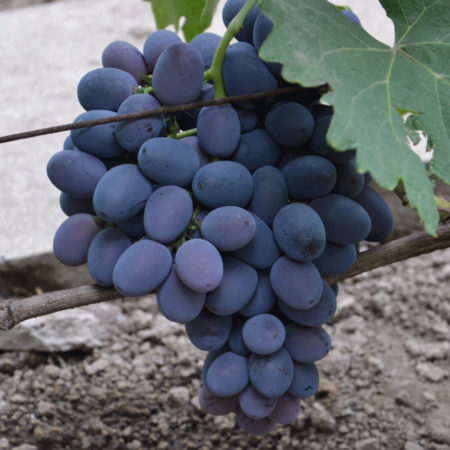
The hybrid is considered uncovered, but in areas with a harsh climate, they still remove the vine from the support before wintering and harbor. The method is traditional: they put the shoots in a trench, slightly cover them with spruce branches (use arcs of wire), then burlap. Snow will complete the job by safely covering the vine from frost.
In the spring, as soon as the snow melts, the grapes are opened. It is advisable not to overdo the bushes under cover, otherwise the shoots will be sprinkled when warm weather sets in.
Disease prevention
The hybrid form of the Furshetny grape proved resistant to fungal infections. This does not cancel the mandatory preventive treatments, inspection of shoots, leaves and berries.
Resistance to mildew and oidium is above average, so if you do not forget about prevention, diseases will not be scary.
Sample processing scheme:
- in spring, when the air warms up to + 5ºC, the bushes are sprayed with the preparations DNOC, Nitrafen;
- when the first leaves appear, they are treated with any fungicides;
- before flowering;
- at a time when the berries will be the size of a pot (use drugs Quadris, Flint);
- after picking berries - with Flint, Strobi compounds.
The indicated dates are suitable for preventive treatments. bushes from pests.Processing is also carried out if you notice traces of the presence of dangerous insects on the bushes. Dangerous spider mite, phylloxera. Apply Actellik, a solution of colloidal sulfur, Fozalon.
The not very demanding Furshetny grape variety showed itself worthy of attention. Gardeners from different regions try to plant hybrid seedlings, get their first harvests and note the good prospects for Furshetny.
Reviews
Eugene, the city of Kamyshin
My Buffet has been growing for 7 years. This year has ripened later than the stated deadline, usually in mid-August we remove the berries. But it doesn’t matter, they managed to collect everything. We like his taste - interesting, with an unusual flavor. Very tasty berries. The pulp is dense, but does not crunch. It is necessary to normalize, otherwise it is heavily overloaded with crops.
Anatoly, Krasnodar Territory
I’m very pleased with the variety, it’s my fourth year already. Left on three-year-olds for 6 clusters pulled easily, the vine was ripening. Even when it rains, the berries do not burst, do not rot. It tastes great, so consider it one of the best varieties for yourself.




 Non-covering winter-hardy grape varieties for Moscow region
Non-covering winter-hardy grape varieties for Moscow region How to keep the vine in winter
How to keep the vine in winter When can I transfer grapes to another place in the fall
When can I transfer grapes to another place in the fall How to cover and prepare grapes for the winter in the suburbs
How to cover and prepare grapes for the winter in the suburbs